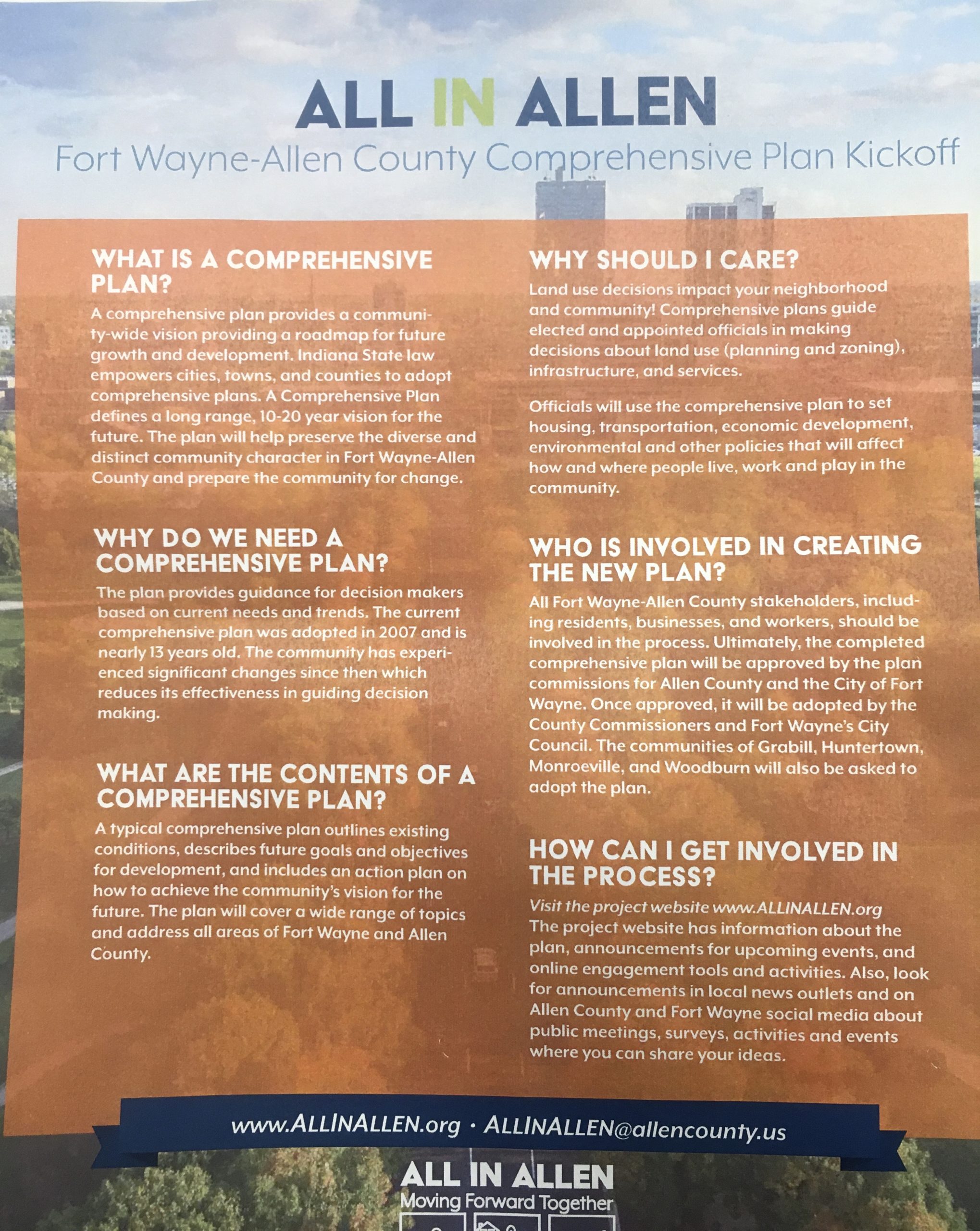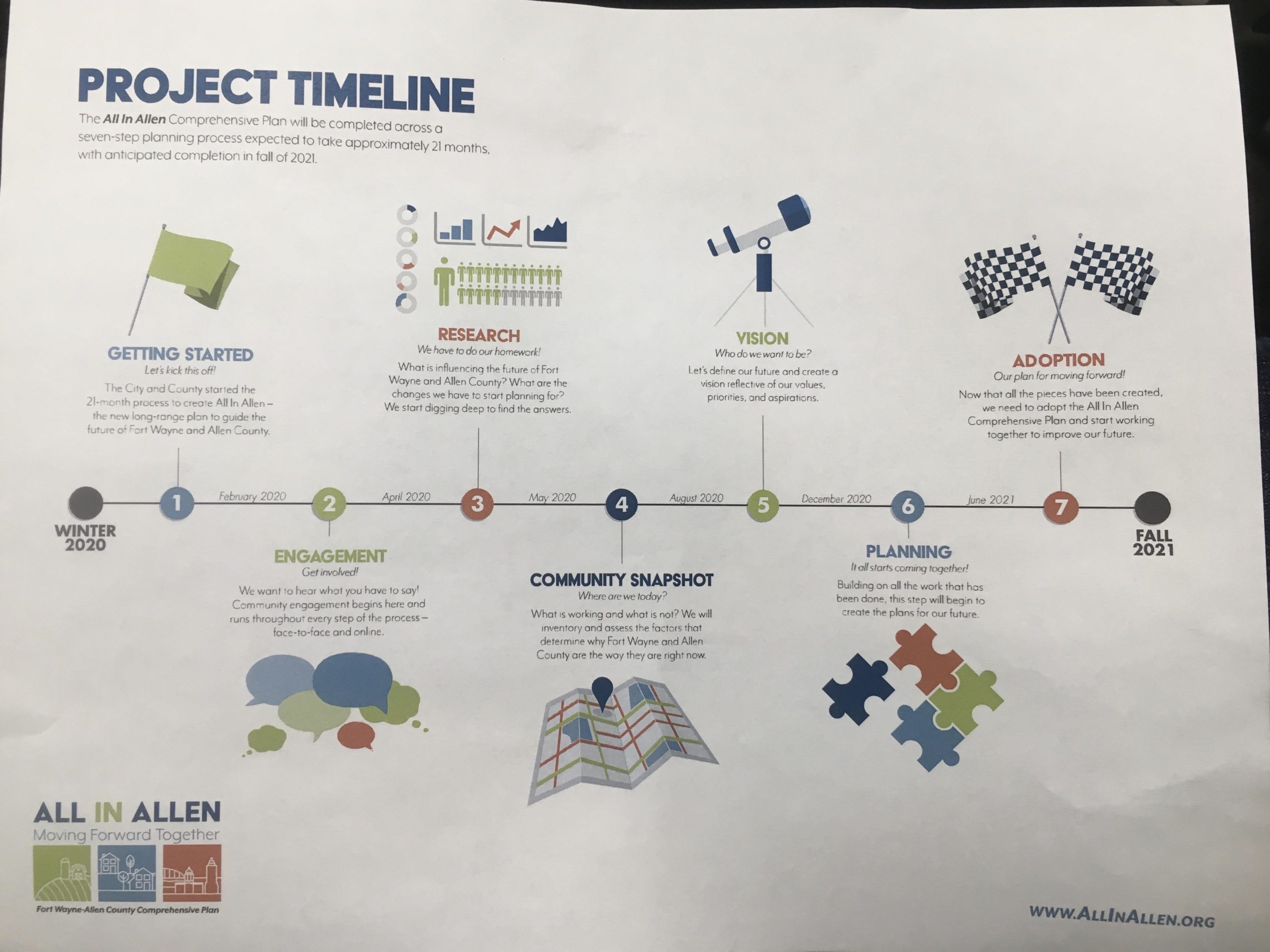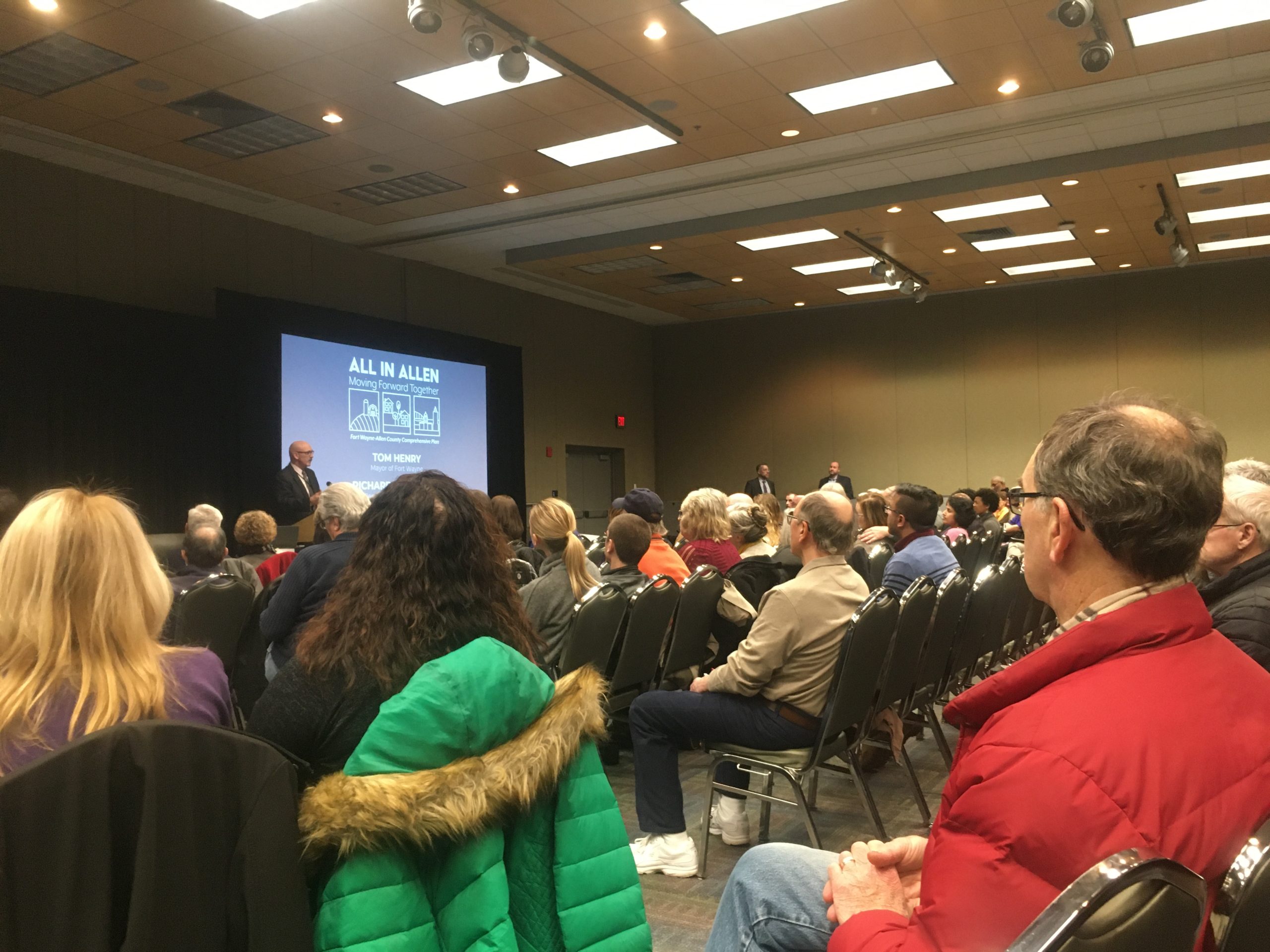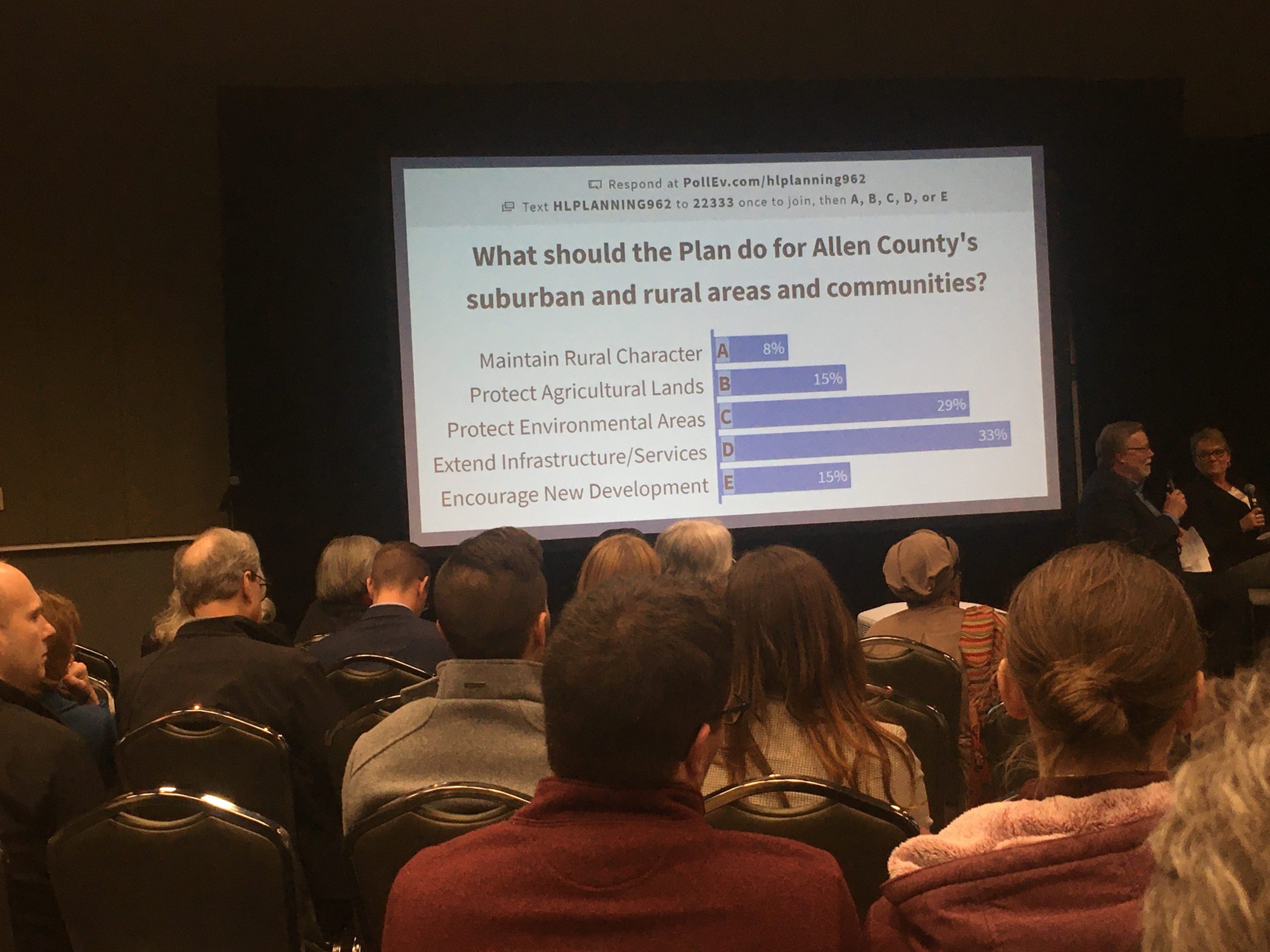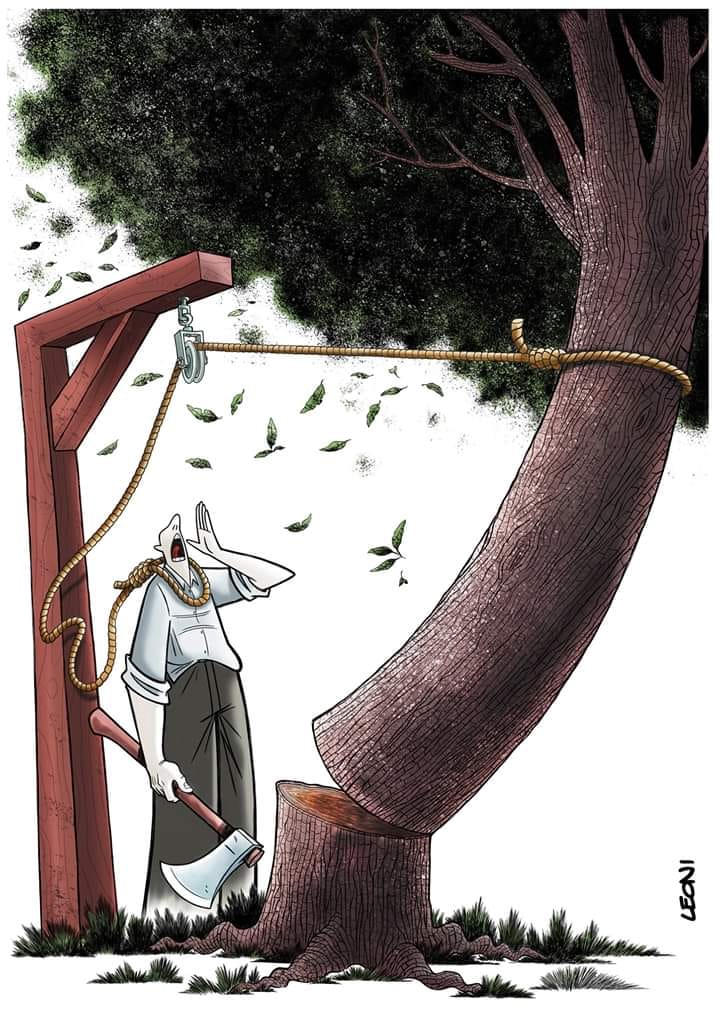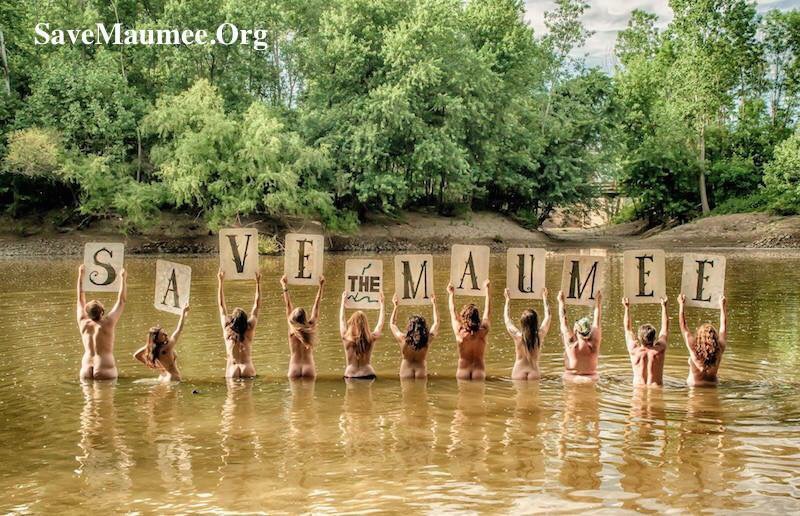Allen County’s current Comprehensive Plan is called Plan-It Allen. FOUND HERE:
Allen County’s new Comprehensive Plan is in the works and its called, All-In Allen. This document will shape our development plans for the next 12-15 years of growth. Fort Wayne City Council will fund a consulting team from Chicago, Houseal Lavigne, to oversee the community plan; guiding land-use, housing, transportation, parks and other development for the entire county. 50 percent of the project costs $333,530, funded by City Council. The other 50 percent will need approval from the Allen County Council, but regardless, around $667,060 it will be paid by our tax payer dollars and Save Maumee wants your voice to be heard. We want these representatives to not simply draft a plan to collect dust on a shelf. We want them to implement the plan and hold people who are financially benefiting from these dollars to be held to higher environmental standards.
“The consulting team will work with local leaders to develop a plan that will create a broad, shared vision for future growth and development. The community’s last comprehensive plan was adopted in 2007. The city says many of the goals of the plan have been either accomplished or are outdated, requiring a new comprehensive plan.
The project is expected to kick off in January 2020 and be completed at the end of 2021.” http://www.fwcommunitydevelopment.org/news/602-consulting-team-chosen-for-development-of-community-s-next-comprehensive-plan (Fort Wayne Community Development, accessed February 10, 2020).
We need to public to attend these meetings so the All-In Allen will take into consideration environmental concerns when considering land-use; like preserving habitat, make suggestions on how to improve & protect water quality, remove invasive species, and keep health of our community in the front-of-the-minds of new development. (fingers crossed)
In 2007, 127 stakeholders & constituents wrote Plan-It Allen. The cost of this plan approached $250,000 of tax payer dollars. It was not a suggestion, it was the wishes of the public in which this document served. “Comprehensive plans are not the last word on allowing or disallowing land use, but they act as a guide for zoning and other development decisions.”
https://www.journalgazette.net/news/local/20190817/plan-consultant-choice-imminent (Journal Gazette, August 17, 2019)
After attending the first meeting on February 19, 2020 a few things stood out and Save Maumee would like to draw the public’s attention to the following considerations when attending these outreach meetings.
- What are the measurable results from Plan-It Allen? Any results to report?
- How has Allen County adhered to the last comprehensive plan?
- How are developers, planners, farmers, industry, surveyors, conservation districts working this plan into their own?
- Is building homes, factories and store-fronts the only way to measure success of this plan?
- How is this document going to guide policies? Specifically?
Please ask questions and speak-up! This is the only way to incorporate your views into this plan.
The speaker Lisa Dunaway, owner of Sensible Ecology was very knowledgable, but did not speak to 1 example of ecology in the plan or anywhere in her presentation. I assumed this was intentional because she may have been warned not to discuss her expertise due to the nature of the DEVELOPMENT meeting. The most interesting fact I learned from Dunaway? Millennials (born between 1982-1994) are earning 20% less than their parents did.
There were many considerations, some of which were mentioned below. Farmland protection came up a few times. When I think of farmland protection, I definitely think that farmland protection needed no further protection. Hhmm
Save Maumee wanted to draw attention to the following when considering these general policies for the future;
CONSIDERATIONS:
- Native tree and plant choices
- Removal of invasive species
- Less Mowing
- Adaptive re-use of brownfields
- Renewable energy
- Public Transportation
- Water quality protections from land-use
- Wildlife habitat areas
- Zoning / Codes
- Walkable lifestyles
- Drainage Issues (we live in a water rich area and displaced water DOES end up somewhere else)
…and then Rena Bradley (bravely) mentioned, lack of access. Lack of access to education, healthcare, cultivation of talent, lack of access to even money. Thank you Ms. Bradley, because the ones who lack access may also lack being included in this plan.
Save Maumee do not want to waste your time, but helpfully draw your attention to:
85% of wetlands in Indiana no longer exist. Most of the forested river corridors in Allen County have been removed. Water quality, stormwater drainage and sewage issues recognize no political boundaries and need regional coordination. Plan-It-Allen, was developed in 2007 and we want the new document to hold those who are able to make a large income from its contents, accountable to this document in the future. In 2008 streambank stabilization projects were receiving 0 dollars in Indiana. (Soil & Water, 2008) Please invest in Natural Capital.
Save Maumee’s Riparian Buffer Initiative has been working to improve this the most degraded water quality ditches in Allen County to to significantly reduce sediment, phosphorus and nitrogen, while improving habitat, due to lack of riparian buffers, urban land-use, CSO’s, septic tank failures, Dissolved Reactive Phosphorus (DRP) and sediment. Are these being considered in the Plan as well?
Here are sections of Plan-It Allen that deserve your attention and should be considered VERY important in All-In Allen;
ES2.B Work with local organizations to protect natural habitat areas, particularly along linear riparian corridors and around critical aquatic communities.
Habitat corridors are important environmental assets. Unlike fragmented natural parcels, these corridors allow animals to move freely and plants to colonize more successfully over a wider area. Allen County, Fort Wayne, local environmental groups, and land trusts should collaborate to protect and expand these critical habitat areas through the acquisition/protection of lands in and adjacent to existing habitat corridors. Particular attention should be paid to rivers and streams in Allen County, which are home to unique aquatic communities that host a variety of rare and endangered mussels, amphibians, and plant species.
OBJECTIVE ES3.
PRESERVE AND IMPROVE THE QUALITY OF GROUNDWATER AND SURFACE WATER RESOURCES.
Water is a vital resource that supports agriculture, industry, household needs and recreation opportunities. The following strategies provide recommendations for protecting the County’s groundwater and surface water resources. The Utilities Chapter addresses a number of issues related to the protection and preservation of water resources.
ES1.D: Camp Scott Wetlands restoration project, located in southeast Fort Wayne, has helped to alleviate storm water issues in the area.
ES2.C: Garlic mustard shown here is considered a problematic invasive plant species.
ES3.B Support and collaborate in the establishment of watershed management plans that recommends actions to address major sources of surface water contamination.
Based on assessment data from the Indiana Department of Environmental Management (IDEM), which was developed as part of the Total Minimum Daily Load (TMDL) for the St. Mary’s and Maumee Rivers, the overall quality of surface water in Allen County can generally be described as “good to fair.” However, high levels of E. coli, nutrients, PCBs, and mercury in fish have been found in certain segments of the County’s streams. IDEM has designated these segments as “impaired”. Watershed management plans which also address transported sediments may be developed, using a stakeholder involvement process, to address each of these contaminants. Allen County and Fort Wayne should collaborate with local watershed management groups, the Allen County-
Fort Wayne Board of Health, and other stakeholders in the consideration of these management plans to address these surface water contaminants.
OBJECTIVE ES4.
PROTECT THE NATURAL AND BUILT ENVIRONMENT THROUGH COMPREHENSIVE FLOODPLAIN MANAGEMENT INITIATIVES. Over the years, Allen County’s natural green infrastructure in floodplains, and in the watershed in general, have been lost to
development and agricultural uses. As a consequence, floods have become more damaging to both the natural and built environment. The following strategies present recommendations for managing floodplains and restoring green infrastructure in a manner that benefits both human and ecological communities.
ES4.A Using the No Adverse Impact principle as a guide, develop a program to map floodplains, track impacts of floods and enhance green infrastructure in floodplains.
The No Adverse Impact management principle supported by the Indiana Association of Floodplain and Stormwater Managers implies that any action taken by a property owner should not negatively affect the rights of other property owners, as measured in terms of flooding, erosion and sedimentation. It also looks at floodplain management from a community-based perspective, rather than relying upon regulations imposed by FEMA. Allen County, Fort Wayne, and local watershed groups should use the NAI principle to develop an appropriate floodplain management program. Initiatives may include floodplain mapping, flood tracking and monitoring, introduction of riparian overlay districts, wetlands restoration and the restoration of green infrastructure within floodplains.
ES4.B Consider tools, such as overlay districts along river basins and streams to encourage the expansion
of riparian buffers and enhance public access to waterfronts.
Riparian zones surrounding rivers and streams help filter sediments and nutrients, and mitigate the effects of storms and flooding. Riparian buffers are also aesthetically pleasing and
can lend themselves to recreation opportunities in the form of greenways and trails. The forested corridors that were originally found along waterways throughout the County have been greatly diminished to meet agricultural, development and drainage needs. Allen County and Fort Wayne should collaborate with watershed partners to develop plans for limiting development along waterways, restoring and protecting riparian corridors,
and enhancing public access to waterfronts. The Fort Wayne
ES1.B: Acres Land Trust tour of one of its many preserve areas.
Environmental Stewardship
Rivergreenway Overlay District, as well as the local floodplain ordinances, serve as an exemplary tool for defining and protecting riparian zones, mitigating flooding impacts, and improving human access to waterways. Similar overlay districts may be applied along rivers and streams throughout the County.
ES4.C Provide education to the public about the natural benefits, protection and restoration of floodplain and wetland areas, and the laws pertaining to floodplain development.
Educate the public through the provision of information, publications and other materials about the natural benefits of floodplains and wetlands, how to protect and restore floodplain and wetland areas and the federal, state and local ordinances which pertain to floodplain development.
OBJECTIVE ES5.
ENCOURAGE BROWNFIELD REDEVELOPMENT.
Brownfields are abandoned or underutilized properties that have real or perceived environmental contamination, which may constrain redevelopment potential. While federal funding and tax incentives are available to address these problems, local governments often must take the lead in guiding the cleanup and redevelopment of these sites.
ES5.A Develop an inventory of brownfields.
Through a regional brownfield inventory, government and stakeholder groups should work together to identify and characterize brownfields that impact the Fort Wayne-Allen County area in order to better understand the extent of cleanup efforts that will be required.
ES5.B Set priorities for brownfield redevelopment in the region.
By prioritizing brownfield redevelopment projects, communities can better target investments, leverage funding for key projects
and maximize impacts in terms of economic recovery and environmental mitigation.
ES5.C Secure resources to assist with assessment, remediation and redevelopment of brownfields.
Federal, state, and local governments can all provide assistance in the assessment, remediation, and redevelopment of brownfields. This assistance can come in the form of tax incentives, grants, low-interest loans, technical assistance and liability protection. The Environmental Protection Agency offers extensive information on funding and financing opportunities.
OBJECTIVE ES6.
ENCOURAGE UTILIZATION OF GREEN BUILDING TECHNOLOGIES TO PROMOTE SUSTAINABLE DEVELOPMENT.
Whenever possible, major civic, institutional and governmental uses and developments should be designed and operated using the principles of the latest “green” building technologies.
ES6.A Incorporate green building technologies into community informational and educational materials.
Green technologies are design and construction practices that significantly reduce or eliminate the negative impact of buildings on the environment and occupants in five broad areas:
• Sustainable site planning;
• Safeguarding water and water efficiency;
• Energy efficiency and renewable energy;
• Conservation of materials and resources; and • Indoor environmental quality.
The U.S. Green Building Council has adopted the Leadership in Energy and Environmental Design (LEED) Green Building Rating System for the design, construction and certification of the world’s “greenest” buildings and developments. The realization of the true environmental impact of building and construction is driving the movement forward.
ES.5: This vacant commercial property, originally utilized as a gas station, is now considered to be a brownfield site.
Green roofs are one example of a green building technology.
ES6.B Support the recommendations of the City of Fort Wayne’s “Green Ribbon Commission.”
Early in 2006, Mayor Graham Richard announced the formation of a “Green Ribbon Commission” to help the City develop a comprehensive energy and air quality improvement strategy
for the community. The final report, issued in September of 2006, contains a comprehensive set of recommendations, an action plan, and goals to reduce energy costs reduce energy consumption, and improve air quality. The report covers the areas of both community energy use (residential, commercial, and transportation), as well as government usage (buildings, vehicle fleets, employee commutes and street lights). Coordination with the recommendations of Plan-it Allen! is encouraged.
Please consider becoming a Member of Save Maumee Grassroots Organization.

